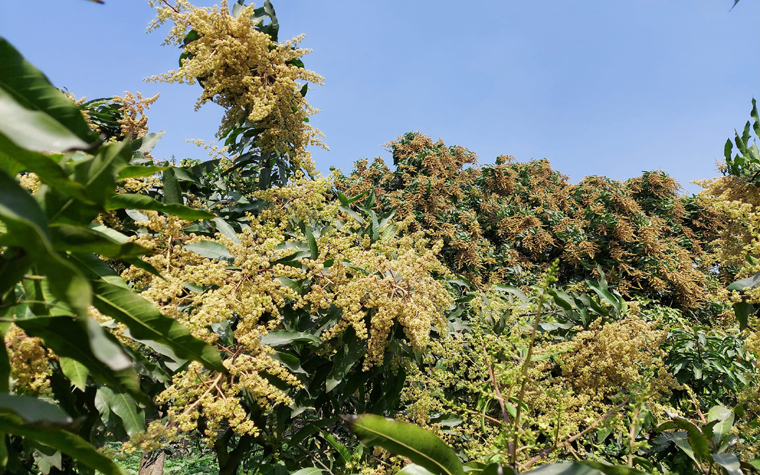
RAJSHAHI, Feb 28, 2023 (BSS)-Like the previous years and with the advent of the spring after winter, the mango trees come into blossom in abundance amid favorable climatic conditions everywhere in the region, including its vast Barind tract.
The blooming mango flowering at this stage predicts an excellent production of the most popular fruit in the region this season, if the climatic condition remains favourable till its harvesting, experts and scientists said.
Principal Scientific Officer of Fruit Research Station Dr Shadiqul Islam said the prevailing climatic conditions are suitable for mango flowering and budding and thousands of mango trees have already worn eye-catching looks with huge blooms.
Flowering began in the middle of January and will continue till mid-March.
Around 65 to70 percent mango trees have already sprouted buds in Chapainawabganj while75 to 80 percent in Rajshahi. The remaining trees are expected to sprout within the next couple of weeks.
Dr Islam said the farmers have been caring and taking care to prevent the flower dropping and damaging as well as to make mango farming successful everywhere.
There are around 35 lakh mango trees of different ages on some 23 thousand hectares of land in the region, said officials concerned of the Department of Agriculture Extension (DAE).
The number of growing mango trees has been increasing in the region for the last ten to fifteen years as a result of greater interest among the people. Mango, the leading seasonal cash crop of the northwestern region, vitalizes the overall economy of Rajshahi and Chapainawabganj districts.
Dr Mukhlesur Rahman, Principal Scientific Officer of Regional Horticulture Research Centre, said every year new mango orchards, especially of Amrapali, BARI mango-3 and 4 varieties are rapidly increasing in the districts.
Naogaon was long known for paddy cultivation, but for the last couple of years it became the highest mango-producing district, surpassing the mango capital of Rajshahi and Chapainawabganj.
Dr Rahman said Chapainawabganj still has the highest amount of land covered by mango orchards, but Naogaon saw a one-and-a-half-times increase in its mango farm acreage annually over the last 10 years, according to the latest official data given by the DAE.
The area covered by mango orchards in Naogaon increased by 14,925 hectares in the period; while the increase was 9,520 hectares in Chapainawabganj.
Mango farming is not only increasing, but it is changing as well. Instead of creating mango orchards for a hundred years or more, farmers are targeting only 10 years.
Normally 10 mango trees are planted in one bigha of land, but in the new farming method, farmers can plant up to 200 trees in the same space, said Md Nuruzzaman, a mango grower of Porsha upazila of Naogaon.
The growth of mango orchards is the highest in two Naogaon upazilas- Porsha and Sapahar. They have 72 percent of the orchards of the district, says DAE.
"These trees will bear fruit for 10 years or less, and then we have to uproot them and replant."
On behalf of the FRS and DAE, many of the grassroots mango farmers were imparted training to yield maximum output side by side with safe production after the best uses of modern technologies.
Additional Director of the DAE Shamsul Wadud said the farmers have been caring and taking measures for making mango farming successful everywhere.
The farmers have been keeping contacts with the agriculture officers at the field levels to control the possible attacks by hoppers and some other pest attacks on the mango flowers.